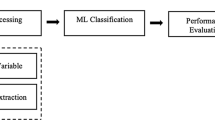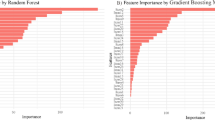Abstract
Obsessive-compulsive disorder (OCD) is extremely common, but early detection is difficult because symptoms do not appear until puberty. Therefore, it is crucial to identify the causes of this mental illness. Making an early and accurate diagnosis of OCD in children and adolescents is essential to preventing the long-term problems. Several studies have looked at ways to recognise OCD in children, but their accuracy was not very high and they only included a few features and participants. Therefore, the purpose of this study was to examine the detection of OCD utilising machine learning algorithms and 667 features from Young Minds Matter (YMM), Australia’s nationally representative mental health survey of children and adolescents aged 4 to 17 years. According to the internal CV score of the Tree-based Pipeline Optimization Tool (TPOTClassifier), the performance of the suggested technique has been evaluated on the YMM dataset using three of the most optimal algorithms, including Random Forest (RF), Decision Tree (DT), and Gaussian Naïve Bayes (GaussianNB). GaussianNB outperformed all other methods in classifying OCD with 91% accuracy, 76% precision, and 96% specificity, despite significant variation in model performance.
Access this chapter
Tax calculation will be finalised at checkout
Purchases are for personal use only
Similar content being viewed by others
References
Murray, C.J., Lopez, A.D., World Health Organization: The global burden of disease: a comprehensive assessment of mortality and disability from diseases, injuries, and risk factors in 1990 and projected to 2020: summary. World Health Organization (1996)
Burke, R.: The Lava Tube: A Christian’s Personal Journey with Obsessive Compulsive Disorder. Wipf and Stock Publishers (2017)
Larson, S., et al.: Chronic childhood trauma, mental health, academic achievement, and school-based health center mental health services. J. Sch. Health 87(9), 675–686 (2017)
Bloch, M.H., et al.: Adulthood outcome of tic and obsessive-compulsive symptom severity in children with Tourette syndrome. Arch. Pediatr. Adolesc. Med. 160(1), 65–69 (2006)
Lenhard, F., et al.: Prediction of outcome in internet-delivered cognitive behaviour therapy for paediatric obsessive-compulsive disorder: a machine learning approach. Int. J. Methods Psychiatr. Res. 27(1), e1576 (2018)
Yang, X., et al.: Multivariate classification of drug-naive obsessive-compulsive disorder patients and healthy controls by applying an SVM to resting-state functional MRI data. BMC Psychiatry 19(1), 1–8 (2019)
Hasanpour, H., et al.: Novel ensemble method for the prediction of response to fluvoxamine treatment of obsessive–compulsive disorder. Neuropsychiatr. Dis. Treat. 14, 2027 (2018)
Askland, K.D., et al.: Prediction of remission in obsessive compulsive disorder using a novel machine learning strategy. Int. J. Methods Psychiatr. Res. 24(2), 156–169 (2015)
Bu, X., et al.: Investigating the predictive value of different resting-state functional MRI parameters in obsessive-compulsive disorder. Transl. Psychiatry 9(1), 1–10 (2019)
Findley, D.B., et al.: Development of the Yale Children’s Global Stress Index (YCGSI) and its application in children and adolescents with Tourette’s syndrome and obsessive-compulsive disorder. J. Am. Acad. Child Adolesc. Psychiatry 42(4), 450–457 (2003)
Hafekost, K., et al.: Validation of the adolescent self-esteem questionnaire: technical report. Telethon Kids Institute and the Graduate School of Education, The University of Western Australia, Perth, Australia, vol. 15, no. 10, p. 2018 (2017)
Hafekost, J., et al.: Methodology of young minds matter: the second Australian child and adolescent survey of mental health and wellbeing. Aust. N. Z. J. Psychiatry 50(9), 866–875 (2016)
Haque, U.M., Kabir, E., Khanam, R.: Detection of child depression using machine learning methods. PLoS One 16(12), e0261131 (2021)
Le, T.T., Fu, W., Moore, J.H.: Scaling tree-based automated machine learning to biomedical big data with a feature set selector. Bioinformatics 36(1), 250–256 (2020)
Kursa, M.B., Rudnicki, W.R.: Feature selection with the Boruta package. J. Stat. Softw. 36(11), 1–13 (2010)
Kursa, M.B.: Boruta for those in a hurry (2020)
Breiman, L.: Random forests. Mach. Learn. 45(1), 5–32 (2001)
Olson, R.S., et al.: Evaluation of a tree-based pipeline optimization tool for automating data science. In: 2016 Proceedings of the Genetic and Evolutionary Computation Conference (2016)
Laura, I., Santi, S.: Introduction to data science. In: Laura, I., Santi, S. (eds.) Introduction to Data Science: A Python Approach to Concepts, Techniques and Applications, pp. 1–4. Springer, Cham (2017). https://doi.org/10.1007/978-3-319-50017-1_1
Nilsson, N.J.: Introduction to Machine Learning (1997)
Kharya, S., Soni, S.: Weighted naive bayes classifier: a predictive model for breast cancer detection. Int. J. Comput. Appl. 133(9), 32–37 (2016)
Japkowicz, N.: Learning from imbalanced data sets: a comparison of various strategies. In: AAAI Workshop on Learning from Imbalanced Data Sets. AAAI Press, Menlo Park (2000)
Mandrekar, J.N.: Receiver operating characteristic curve in diagnostic test assessment. J. Thorac. Oncol. 5(9), 1315–1316 (2010)
Japkowicz, N., Shah, M.: Evaluating Learning Algorithms: A Classification Perspective. Cambridge University Press, Cambridge (2011)
McKay, D., et al.: A critical evaluation of obsessive–compulsive disorder subtypes: symptoms versus mechanisms. Clin. Psychol. Rev. 24(3), 283–313 (2004)
Foa, E.B., et al.: The obsessive-compulsive inventory: development and validation of a short version. Psychol. Assess. 14(4), 485 (2002)
Abramowitz, J.S., et al.: Symptom presentation and outcome of cognitive-behavioral therapy for obsessive-compulsive disorder. J. Consult. Clin. Psychol. 71(6), 1049 (2003)
Author information
Authors and Affiliations
Corresponding author
Editor information
Editors and Affiliations
Ethics declarations
Statements and Declarations
We confirm that all authors declare that they have no competing interests. The paper has been seen and approved by all authors and that they agree on the order of authorship. We ensure that this manuscript has not been published elsewhere and is not under consideration by another conference. All authors have read and approved the manuscript and agreed to be accountable for all aspects of the work.
Rights and permissions
Copyright information
© 2022 The Author(s), under exclusive license to Springer Nature Switzerland AG
About this paper
Cite this paper
Haque, U.M., Kabir, E., Khanam, R. (2022). Detection of Obsessive-Compulsive Disorder in Australian Children and Adolescents Using Machine Learning Methods. In: Traina, A., Wang, H., Zhang, Y., Siuly, S., Zhou, R., Chen, L. (eds) Health Information Science. HIS 2022. Lecture Notes in Computer Science, vol 13705. Springer, Cham. https://doi.org/10.1007/978-3-031-20627-6_2
Download citation
DOI: https://doi.org/10.1007/978-3-031-20627-6_2
Published:
Publisher Name: Springer, Cham
Print ISBN: 978-3-031-20626-9
Online ISBN: 978-3-031-20627-6
eBook Packages: Computer ScienceComputer Science (R0)




